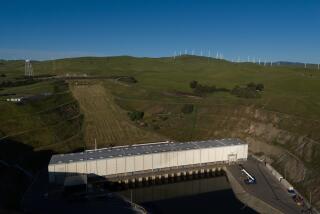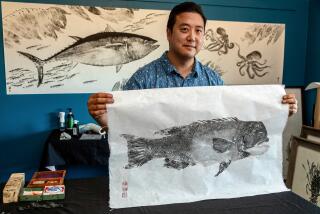Tuna Canner Funds Study Testing Way to Save Dolphins
In an effort to assure that the Eastern Tropical Pacific remains an active but dolphin-safe fishery, Bumble Bee Seafoods Inc. announced Wednesday it is spending $500,000 to study how fishermen may lure their desired catch--tuna--away from dolphin-rich areas.
The study, to be conducted by the National Marine Fisheries Service and the Inter-American Tropical Tuna Commission, seeks to capitalize on the tuna’s propensity to swim near floating debris.
If tuna can be persuaded to follow man-made floats instead of dolphins, researchers say, fishermen will be able to set their nets without fear of killing marine mammals.
“If we’re successful, that will provide a mechanism for catching large tuna without catching dolphins,” said Dr. James Joseph, director of the IATTC. But he called the study, which begins in earnest later this month, a “gamble” because so little is known about why tuna find floating objects so attractive.
Mike McGowan, a Bumble Bee vice president and director of its Alternative Fishing Technologies program, said the company hopes the study will encourage U.S. fishermen to continue fishing in the Eastern Tropical Pacific, a triangular section of the Pacific Ocean bounded by San Diego, Chile and Hawaii.
That 7.5-million-square-mile region is the only place in the world where dolphins often swim directly over schools of tuna, and until last year, many skippers used dolphins there as markers to indicate where to set their nets.
But since April, 1990, when the world’s three largest tuna canners--Bumble Bee, Starkist and Chicken of the Sea--agreed to stop buying and selling tuna caught with dolphins, many U.S. fishermen have chosen to drop their nets elsewhere.
In one year, the number of U.S. fishing boats working in the Eastern Tropical Pacific has gone from 30 to 9, according to one estimate--a shift that is inconvenient for Bumble Bee and other companies that rely on tuna processing plants in Puerto Rico, across the Panama Canal from the Eastern Tropical Pacific.
Furthermore, McGowan acknowledged, Bumble Bee hopes that its study of man-made, radio-equipped floats--called fish aggregate devices, or FADs--will help remedy any damage done to the company’s image last December, when an environmental group placed full-page newspaper advertisements attacking the company’s environmental integrity.
The group, the San Francisco-based Earth Island Institute, accused Bumble Bee and its Thailand-based parent company, Unicord, of continuing to accept tuna caught in nets that maim dolphins.
Bumble Bee fired back with ads of its own that defended its products as dolphin-safe. Already, the company had decided to fund the study announced Wednesday, McGowan said.
“To have made that commitment and get slammed was especially hard,” he said, but now, Bumble Bee is on much better terms with animal protection advocates. “We’ve worked all those things out.”
David Phillips, Earth Island’s executive director, on Wednesday applauded Bumble Bee’s research project.
“We are very supportive of developing alternatives that don’t require any chasing or encircling of dolphins, so the FADs we think are a very good direction to be looking in,” he said. He cautioned, however, that such technologies are only useful in the context of enduring dolphin-safe policies.
“The commitment from the various industries to stop setting nets on dolphins is more important than the commitment to try to find the alternate technologies,” he said. “If the FAD program comes up empty, no one should say, ‘OK, we tried to find an alternative, so let’s go back to the way we were doing it.’ ”
Blair Palese, a Washington-based spokeswoman for Greenpeace, agreed.
“We’ve been skeptical in some ways that we’ll hear more talk than action on this,” she said. “We say: Clean up your act and not your image. It’s great to see them going a step further--actually working to solve a problem, instead of pretending it will go away if you come up with a good PR campaign.”
Scientists unveiled a few of the FADs at a floating news conference Wednesday on a boat off Point Loma. Later this month, they plan to set 60 FADs of varying designs adrift off the California coast. The FADs will be monitored, and it will take months before they become “seasoned” and attract fish. The results will help shape the rest of the study.
Researchers stressed that they are in the early stages of understanding why tuna have been observed congregating around float logs or palm fronds.
One theory is that the objects provide some protection from predators. Another theory is that because currents often sweep floating objects into organically rich areas, fish have “learned” to stick close--an adaptation that could lead fish to their next meal.
But at this point, said Joseph, the IATTC director who is participating in the study, there are more questions than answers.
Are fish attracted to the what floats at the surface, or what hangs in the water below? Do color, shape, sound or smell play a role? And what will attract larger, meatier fish, which are less commonly seen near debris?
Of course, the entire study will be moot if scientists are wrong in their supposition that tuna tag along with dolphins, and not the other way around.
“We’re not certain who is following whom,” Joseph said. “These are the first steps. We have no guarantee it’s going to be successful. Time will tell.”
More to Read
Inside the business of entertainment
The Wide Shot brings you news, analysis and insights on everything from streaming wars to production — and what it all means for the future.
You may occasionally receive promotional content from the Los Angeles Times.










